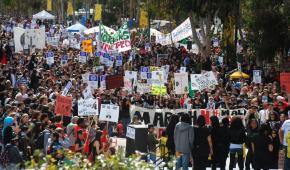Next steps in the fight against California cuts
looks at the discussion over how to strengthen the movement to defend public education in California.
MORE THAN 100 activists from across California gathered in Los Angeles April 24 to debate next steps for the fight against the devastating cutbacks facing public education. While the meeting was smaller than hoped for, and was often fraught with disagreement, there are some important lessons to be drawn from it--and every reason to be optimistic about moving forward.
The main achievements of the conference were to set a date and location for the next statewide mass action--October 7--and for the next anti-cuts conference, which will happen October 16 at San Francisco State University. The other key outcome was the first steps toward the formation of an ad hoc volunteer coordinating committee to plan for the fall conference.
We should be clear that despite the many differences of perspective expressed at the conference, these decisions were a crucial step toward deepening and broadening the movement. For example, the fall conference will be the key venue for uniting activists from all sectors of public education, and especially from those schools and campuses which saw action on March 4, but which have yet to plug into the broader movement.

This will be crucial for extending the scope and increasing the strength of our movement, as well as for helping us strategize and prepare for what is certain to be a tough year ahead. Similarly, the fall mass action will be crucial to re-igniting the movement following the summer months.
The LA conference achieved this despite logistical problems. Organizers in Fresno had to withdraw their offer to host the conference on April 17, and the LA organizers deserve credit for stepping into the breach at the last minute. This inevitably meant that the conference could not be representative, but it was crucial that it took place at all.
These kinds of problems are to be expected in a brand-new movement, and there are no grounds for trying to attribute blame. But the difficulties do point to the need to take seriously the issue of building statewide organization.
Naturally, there was much discussion about the small size of the meeting, and what conclusions we should draw from this fact. The idea that the numbers present represented most of the mobilized sectors of the movement is simply wrong.
We shouldn't lose sight of the fact that, as the handful of K-12 teachers in attendance emphasized, many people only learned the date and location of the conference less than a week ahead of time. It's likely that many who were active on March 4, especially in the K-12 sector, remain wholly unaware that the conference even took place. Simply put, the conference was planned and announced at very short notice, making attendance a possibility only for a small portion of the movement.
ONE OTHER point of contention at the conference was the assessment of the current state of the movement. Those who argued that the conference represented the few active sectors of the movement concluded that the movement is in a state of decline coming out of the March 4 protests.
Of course, with the end of the school year approaching, we will see a lull in the movement, this is not the same thing as saying the movement is in decline.
To say that the movement is in decline, however, implies that the movement is weakening and that activists are becoming demoralized, demobilized or are otherwise abandoning the struggle. Yet every indication is that such an assessment is incorrect. In fact, more people across the state are prepared to fight back--whatever they may understand that to mean--than at any time since the movement began last September.
Nevertheless, it would also be wrong to simply claim the reverse--that the movement is straightforwardly on the rise. The fact is that the struggle across the state is highly differentiated. Some sectors are increasingly optimistic and willing to fight, while others are on the defensive or facing extremely tough challenges--the current contract fight by Oakland teachers is just one example.
The key point is that the anti-cuts movement has never been broader than it is now, and we must not lose sight of that fact. Optimism about--and commitment to--a fightback varies considerably. But the numbers open to uniting in struggle have never been greater.
The size and character of the March 4 protests bear out this analysis. March 4 was the high-water mark of the movement so far, with tens of thousands--perhaps a hundred thousand--people across the state getting involved, many for the first time.
Consciousness for many of those in the movement, as is often the case, is currently greatly ahead of the level of organization. In other words, there's simply no clear place for newly radicalizing activists to get plugged in to the broader statewide movement.
Bridging this gap between the willingness to fight--and the kind of organization needed to carry out that fight--is our number one task. We need to bring the widest possible audience together for a truly representative conference in the fall. Organizing another statewide day of action against the cuts will help us achieve that goal.
Our movement has to take stock of the fact that politicians, university trustees and administrators have only just begun this latest assault on what is left of public education. Therefore, we need to find the most effective way to knit together those ready to fight and to win new layers of people to the struggle.
The April 24 meeting in LA whatever its shortcomings, helped point the way forward. Our task now is to devote our energies to building a fall day of action, followed by a broad and representative conference that can help build the movement.


